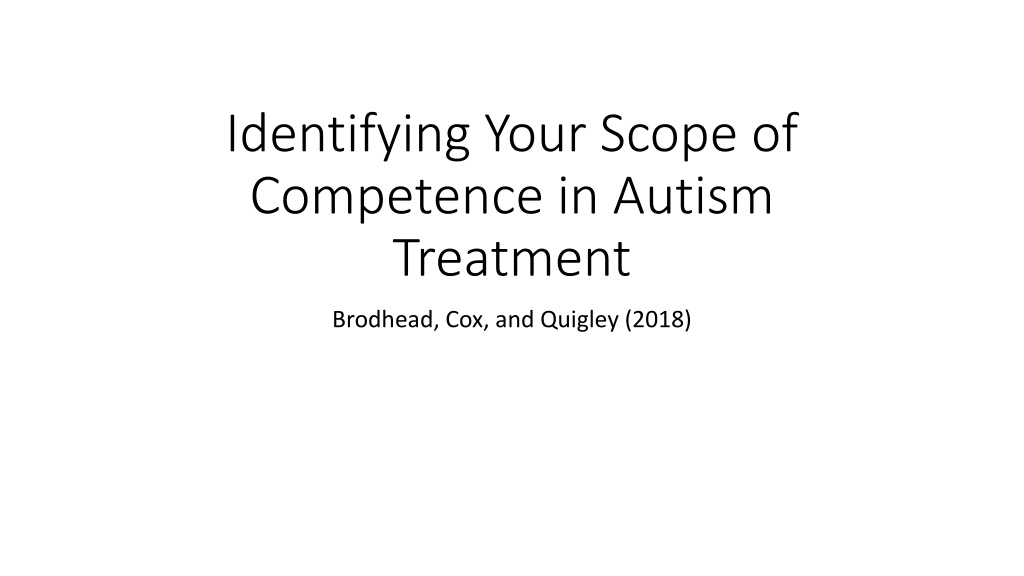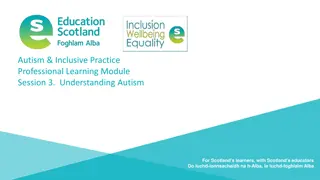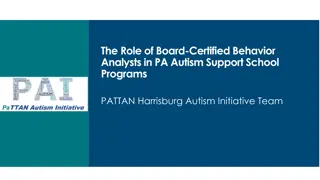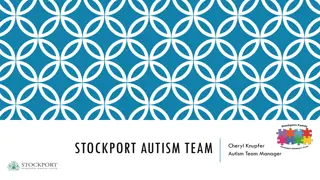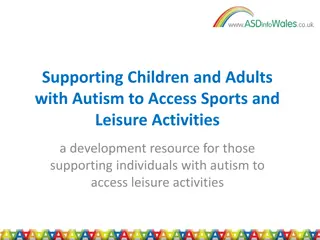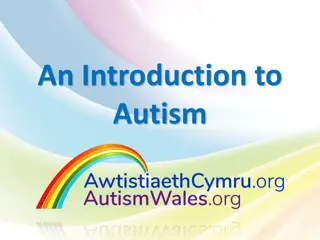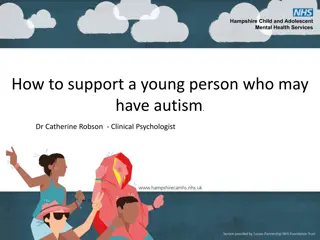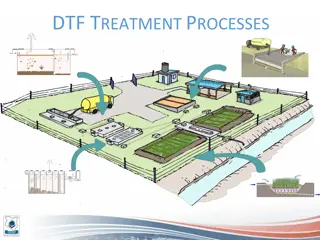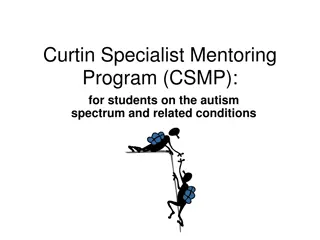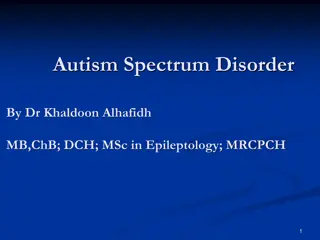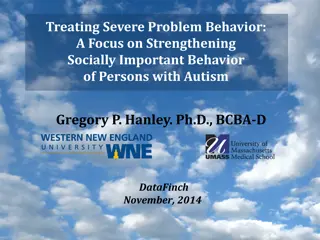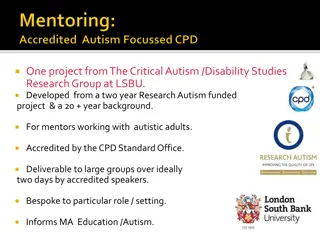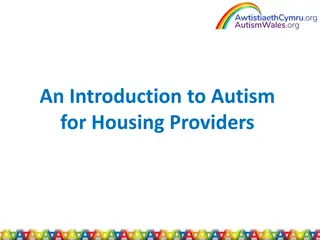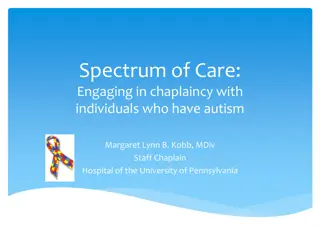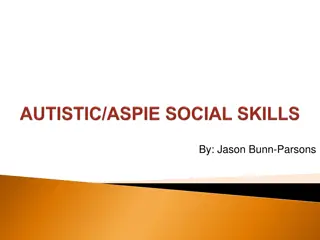Scope of Competence in Autism Treatment
Exploring the importance of practicing within one's scope of competence in autism treatment. Discusses how to identify and broaden your scope, when to seek further training or refer a client. Highlights the negative outcomes of practicing outside your competence and the scope of competence within the practice.
Download Presentation

Please find below an Image/Link to download the presentation.
The content on the website is provided AS IS for your information and personal use only. It may not be sold, licensed, or shared on other websites without obtaining consent from the author.If you encounter any issues during the download, it is possible that the publisher has removed the file from their server.
You are allowed to download the files provided on this website for personal or commercial use, subject to the condition that they are used lawfully. All files are the property of their respective owners.
The content on the website is provided AS IS for your information and personal use only. It may not be sold, licensed, or shared on other websites without obtaining consent from the author.
E N D
Presentation Transcript
Identifying Your Scope of Competence in Autism Treatment Brodhead, Cox, and Quigley (2018)
Chapter Overview Understanding the need to practice within a scope of competence Scope of competence within scope of practice Identifying your own scope of competence How to broaden your scope of competence When to seek additional training and when to refer a client A need for an honest evaluation
Understanding the Need to Practice Within a Scope of Competence
Understanding the Need The science of behavior analysis is applicable to many populations, settings, and problems Geriatrics Organizations Workplace safety Substance abuse and misuse Writer s block Landmine detection The robust findings may support the conviction of some behavior analysts that their training relative to the principles of behavior is universally applicable
Understanding the Need Although the science of behavior analysis has demonstrated success across many populations, settings, and problems, it does not indicate all behavior analysts are adequately trained to universally apply the principles. Behavior analysts are expected to only practice within their scope of competence.
Understanding the Need Three possible negative outcomes of practicing outside your scope of competence Waste of treatment time and resources Misuse or misapplication of behavior analysis Impacted ability to continue to practice as a behavior analyst
Scope of Competence Within Scope of Practice
Scope of Competence Within Scope of Practice Scope of practice Defined at the level of the profession The range of activities in which members of a profession may be authorized to engage in by virtue of holding a credential or license The range of activities might be defined by a credentialing body, certifying agency, or licensing laws These entities might define a professions scope of practice differently, even in conflict with each other
Scope of Competence Within Scope of Practice Scope of practice Allows identification of individuals who have met minimum competencies to engage in a range of activities Funders and consumers of helping professions rely upon scope of practice to target outcomes and increase safety
Scope of Competence Within Scope of Practice Scope of competence Defined at the level of the individual professional The professional activities, within the professions scope of practice, the individual professional is competent to perform It is defined by education, clinical training (e.g., practicum, internship), and supervised experience (e.g., number of successful cases across different settings, people, and clinical needs)
Scope of Competence Within Scope of Practice Scope of Practice Scope of Competence
Identifying Your Own Scope of Competence
Identifying Your Own Scope of Competence The BACB Code (i.e., 1.02) and licensure laws, where applicable, indicate a behavior analyst must practice within their scope of competence Many experiences are involved in the process of establishing one s scope of competence. Three relevant areas are: Coursework Setting Supervision
Identifying Your Own Scope of Competence Coursework Settings Supervision
Identifying Your Own Scope of Competence Coursework Although all behavior analysts are required to complete coursework in the same content areas, the content can be presented in different contexts, which further shapes understanding Assessment might be presented in the context of feeding disorders, severe and chronic challenging behavior, or organizational behavior management Courses within a special education program will likely vary from courses presented in a psychology program or a stand-alone behavior analysis program Settings Supervision
Identifying Your Own Scope of Competence Coursework Settings Setting specific training can alter a professional s scope of competence. Experience in a public-school setting is likely to result in awareness of state and federal laws unique to that setting. Whereas an individual working in a hospital program is more likely to learn about the medical model and contingencies selecting behavior in that setting. Development of autism intervention is affected by setting also. A center-based program might focus on smaller group instruction with lower student-to-instructor ratios whereas a public- school setting might focus on classroom and school wide behavior change programs Supervision
Identifying Your Own Scope of Competence Coursework Settings Supervision Although the BACB has a set standard of supervisor and supervision expectations, it does not guarantee an equal experience within or between supervisors There is a distinction between supervision skills and clinical skills. Although a supervisor might have an awareness of the application of relational frame theory to individuals with autism and incorporate the information into office supervision, he may not be able to provide robust clinical opportunities and oversight
Identifying Your Own Scope of Competence Three questions to analyze personal scope of competence. A discussion with a trusted colleague regarding these questions can also be useful. What populations, specific behavioral topographies, and assessment / intervention procedures were covered in depth in my graduate coursework? There is a difference between one unit of content within a course (e.g., two or three weeks of assessment within an introductory class) and entire course covering the same content (e.g., Behavioral Assessment and Treatment)
Identifying Your Own Scope of Competence Three questions to analyze personal scope of competence What populations and specific behavioral topographies have I successfully implemented assessment / intervention procedures under the supervision of a competent BCBA? Although topographies might share similar functions, some topographies present unique challenges for assessment and treatment. The assessment of verbal behavior is uniquely different from self-injury, although both rely on functional assessment processes
Identifying Your Own Scope of Competence Three questions to analyze personal scope of competence What populations, specific behavioral topographies have I successfully and independently implemented assessment / intervention procedures with in a clinical setting? This question emphasizes an ability to practice independently, achieve desirable outcomes, and minimize risk for the individual
How to Broaden Your Scope of Competence
How to Broaden Your Scope of Competence Recognize that you need to broaden your competence Find a qualified supervisor with extensive experience within the particular content area Outline the skills and timeline for completion Sign a contract with the supervisor LeBlanc, Heinicke, and Baker (2009) also suggest contacting relevant literature and professional groups, and pursuing additional certifications and credentials
When to Seek Additional Training and When to Refer a Client
Additional Training and Referring Clients Behavior analysts must make decisions about when to seek additional training or when to refer a client to another professional. This decision can be aided by answering two questions. How much risk is there for the individual and others while seeking training? What is the timeframe for the training that will lead to benefits for the individual?
Additional Training and Referring Clients Scenarios that present minimal risk and shorter times for benefit can likely be solved through training to increase scope of competence Scenarios that present moderate to high risk and longer times for benefit should be solved through referral to a qualified professional An awareness of one s evolving scope of competence can minimize these types of situations from the onset
A Need for an Honest Evaluation Accepting clients outside of one s scope of competence is a complex ethical issue An honest evaluation of your individual skill set and the overall strengths / weakness of your employer are important
A Need for an Honest Evaluation You should have an awareness of the overall strengths / weaknesses of other providers in your region to facilitate client referrals. This information should be objective. Establish cooperative and collaborative relationships with other providers in your region
A Need for an Honest Evaluation Sometimes you are the best option for the client even though it is still out of your scope of competence Code 1.02b indicates you obtain training prior to treatment. Section 2.0 indicates a responsibility to operate in the best interest of the client There might be situations which create conflict between these obligations
